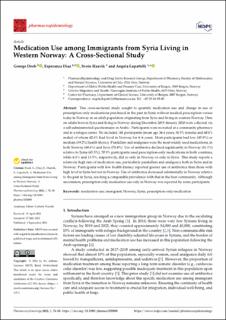Medication Use among Immigrants from Syria Living in Western Norway: A Cross-Sectional Study
Journal article
Published version

Åpne
Permanent lenke
https://hdl.handle.net/11250/3039886Utgivelsesdato
2022-09-01Metadata
Vis full innførselSamlinger
Sammendrag
This cross-sectional study sought to quantify medication use and change in use of prescription-only medications purchased in the past in Syria without medical prescription versus today in Norway in an adult population originating from Syria and living in western Norway. Data on adults born in Syria and living in Norway during December 2019–January 2020 were collected via a self-administrated questionnaire in Arabic. Participants were recruited at a community pharmacy and at a refugee center. We included 148 participants (mean age 36.4 years; 38.5% females and 60.8% males) of whom 62.6% had lived in Norway for 4–6 years. Most participants had low (45.9%) or medium (39.2%) health literacy. Painkillers and analgesics were the most widely used medications, in both Norway (69.6%) and Syria (78.4%). Use of antibiotics declined significantly in Norway (31.1%) relative to Syria (65.5%); 70.9% participants used prescription-only medications in both countries, while 6.1% and 13.5%, respectively, did so only in Norway or only in Syria. This study reports a relatively high rate of medication use, particularly painkillers and analgesics both in Syria and in Norway. Participants with low health literacy reported greater use of antibiotics than those with high level in Syria but not in Norway. Use of antibiotics decreased substantially in Norway relative to the past in Syria, reaching a comparable prevalence with that in the host community. Although uncommon, prescription-only medication use only in Norway was reported by some participants.
